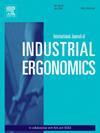Fatigue discrimination of workers in low oxygen environment: a multi-feature fusion method
IF 2.5
2区 工程技术
Q2 ENGINEERING, INDUSTRIAL
International Journal of Industrial Ergonomics
Pub Date : 2025-05-01
DOI:10.1016/j.ergon.2025.103752
引用次数: 0
Abstract
Many plateau areas have abundant fossil energy resources, but the low oxygen environment in the plateau seriously limits the development of exploration work. Monitoring the fatigue status of exploration workers on the plateau is a necessary measure to ensure their safety. In this study, we designed a task-based experiment to explore the behavior of fatigue in exploration operations, with environmental oxygen partial pressure as the variable. Physiological signals including electrocardiogram (ECG), respiration, and oxygen saturation were collected, along with subjective fatigue scale scores. A total of 96 features were extracted from the time domain, frequency domain, and nonlinear domain, and a dataset of fatigue feature for exploration tasks in plateau was constructed. Based on different dimensionality reduction methods and classifiers, a model for discriminating the fatigue state of exploration tasks in plateau was constructed and optimized. The results show that 80 % of the workers had a severe or extreme fatigue state before the end of the task in a 17 % oxygen concentration (Oxygen partial pressure 17.23 kPa) environment. Correlation analysis and XGBoost algorithm show that all signals provide effective contributions to discriminating the fatigue state. Among them, the ECG signal plays a leading role. Finally, through the model building and optimization route of Principal Component Analysis-Support Vector Machines-Differential Evolution Algorithm (PCA-SVM-DE), we constructed a multi-feature information fusion geological exploration operation fatigue state discrimination model. The model achieves an accuracy of 99.01 % in the four-level fatigue classification. The fatigue state discrimination method can be effectively applied in low oxygen working environment to reduce operational risks.
低氧环境下工人疲劳判别:多特征融合方法
许多高原地区拥有丰富的化石能源资源,但高原低氧环境严重限制了勘探工作的开展。对高原勘探工作者的疲劳状态进行监测是保证其安全的必要措施。在这项研究中,我们设计了一个基于任务的实验,以环境氧分压为变量来探索勘探作业中的疲劳行为。收集生理信号,包括心电图、呼吸和血氧饱和度,以及主观疲劳量表评分。从时域、频域和非线性域共提取了96个特征,构建了高原勘探任务的疲劳特征数据集。基于不同降维方法和分类器,构建并优化了高原勘探任务疲劳状态判别模型。结果表明,在氧气浓度为17%(氧分压为17.23 kPa)的环境下,80%的作业人员在作业结束前处于严重或极度疲劳状态。相关分析和XGBoost算法表明,所有信号对疲劳状态判别都有有效贡献。其中,心电信号起主导作用。最后,通过主成分分析-支持向量机-差分进化算法(PCA-SVM-DE)的建模和优化路线,构建了多特征信息融合的地质勘探作业疲劳状态判别模型。该模型在四级疲劳分类中准确率达到99.01%。疲劳状态判别方法可有效应用于低氧工作环境,降低操作风险。
本文章由计算机程序翻译,如有差异,请以英文原文为准。
求助全文
约1分钟内获得全文
求助全文
来源期刊
CiteScore
6.40
自引率
12.90%
发文量
110
审稿时长
56 days
期刊介绍:
The journal publishes original contributions that add to our understanding of the role of humans in today systems and the interactions thereof with various system components. The journal typically covers the following areas: industrial and occupational ergonomics, design of systems, tools and equipment, human performance measurement and modeling, human productivity, humans in technologically complex systems, and safety. The focus of the articles includes basic theoretical advances, applications, case studies, new methodologies and procedures; and empirical studies.

 求助内容:
求助内容: 应助结果提醒方式:
应助结果提醒方式:


